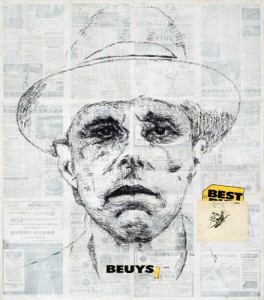« Reviews
Andrés Michelena - The truth will set you free

Andrés Michelena. Best Beuys, 2009. Archival Ink, Acrylic, Collage/ Paper. 49" x 43". Courtesy of the artist
Hardcore Art Contemporary Space
Wynwood Art District, Miami
By Yuleina Barredo
If in fact Andrés Michelena (Caracas, 1963) recognizes that his oeuvre is thematically and stylistically lacking in a constant, continuity could be established in the reflective intentions that accompany his artistic work. The skeptical and ironic attitude, which the artist assumes when he argues about religion, esotericism and spirituality, is maintained in his recent series shown at Hardcore Art Contemporary Space.
Michelena carries the concept of recycling to its highest level of expression. As material he utilizes Chinese newspapers that he treats with chemical substances, thereby providing the material with greater durability. In this process, fragments of original works leap from anonymity to the imaginative collage.
The conceptual nature of this series comes from the deconstruction of iconographic elements adopted by western culture to question the validity of its permanence. Thus, in Polyphilo’s Dream, the capacity of science to respond is placed in doubt through a cyclical process that begins with the famous portrait of Albert Einstein reproduced with the word “free” stamped on it like a seal. A silhouette of Stonehenge, the origins of which have been the subject of so much speculation, completes the nature of the argument. Other associations function through a more cryptic lens, such as those established in the piece Don’t Cry, Master, where the famous Vitruvian Man appears “castrated” by a fig leaf. This latter symbol is identified with the videos of Matthew Barney, a videographer known for his project Cremaster, alluding to the muscle that supports the testicles. Another cycle is completed in which Leonardo Da Vinci is recognized as a pioneer in the study of human anatomy, inspiring others to likewise devote themselves to research.
It should be noted that, in each piece, the significance of the visual discourse is completed with textual support. At times, the artist recombines words or phrases (ego, create, explore, inspire…) seeking textures and zones of intensity through drawing. At others, he places forceful speeches in the mouths of the characters - Tintín, Professor Tornasol and Captain Haddock - extracted from the famous comic strip by the Belgian, Georges Remi “Hergé.”
In touring the Michelena exhibition, we pass by R. U. Mute? a title that alludes to the liberty with which the genius Duchamp presented his controversial urinal at the Salón des Indépendants. Here we find a cyclical rupture from a History of Art perspective, since we recall that, with this irreverence, the French genius cleared the way for the eruption of twentieth-century artistic avant garde. The same polemic position is repeated in Best Beuys, a title manipulated with ludic intention - Best Buy - based on the controversy surrounding Joseph Beuys while he was still alive. The biography of this German artist recognizes his incapacity to keep himself pure when confronted with the tenets and standards of the consumer society. As the well-known phrase states: “The truth will set you free.“
Filed Under: Reviews


































